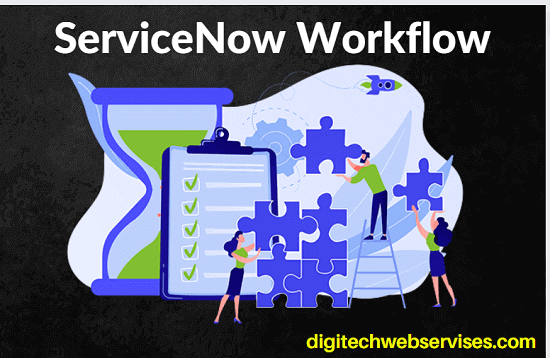ServiceNow Workflow: What Does It Mean
What is ServiceNow Workflow?
Table of Contents
ServiceNow Workflow is a cloud-based platform that enables users to manage their workflows and processes. It is designed to help businesses automate their workflows and processes, and improve efficiency and productivity. ServiceNow Workflow allows users to create, edit, and delete workflow diagrams, and provides a drag-and-drop interface for easy workflow creation.
ServiceNow Workflow provides an easy-to-use drag-and-drop interface that makes it simple to create and modify workflows. You can also use ServiceNow Workflow to automate the approval process for changes to your business processes. Additionally, ServiceNow Workflow integrates with the ServiceNow Change Management module so that you can automatically trigger change approvals when certain conditions are met.
ServiceNow Workflow is a cloud-based platform that enables organizations to automate their business processes. It provides a visual drag-and-drop designer that allows users to create and modify workflows without coding. Workflows can be triggered by events, such as the creation of a new record or the update of an existing record. They can also be run on a schedule, such as daily or weekly. ServiceNow Workflow includes a built-in approvals engine that allows users to route records for approval. The platform also includes tools for monitoring and auditing workflows.
ServiceNow Workflow is a feature that allows you to automate the tasks involved in completing a process. It can be used to create, run, and monitor workflows. ServiceNow Workflow can also be used to visualize the steps involved in a process, and to track the progress of a workflow.
If you have an interest in ServiceNow, our ServiceNow Training will be of great benefit to you.
ServiceNow Workflow Engine
The ServiceNow workflow engine is a powerful tool that enables businesses to automate the flow of work and improve efficiency. The engine provides a graphical user interface that allows users to create and modify workflows without having to write code. The engine also includes a built-in rules engine that can be used to automate decision-making within a workflow.
ServiceNow Workflow Engine is used to automate the approvals and actions associated with ServiceNow Change Management. It provides a graphical representation of an approval process, which can be used to easily understand and modify the process. The workflow engine can also be used to create custom approval processes for other ServiceNow modules such as Service Catalog and Incident Management.
Creating a Workflow
Assuming you want a how-to guide:
Creating a workflow can help bring organization and structure to your projects big and small. By taking the time to map out the steps involved in completing a task, you can identify any potential bottlenecks and plan accordingly. Here’s a step by step guide on how to create a workflow.
- Define the task or project that needs to be completed.
- Break down the task into smaller, more manageable steps.
- Determine what tools or resources will be necessary to complete the task.
- Assign each step in the process to a specific individual or team.
- Set deadlines for each step in the process.
- Create a system for tracking progress and monitoring results.
- Make adjustments to the workflow as needed based on feedback and performance data.
- Celebrate successes and learn from failures to continuously improve your workflow processes over time!
Workflow Editor
In the Workflow Editor, you can create, edit, and delete workflows. A workflow is a set of actions that will be performed on a record when a certain criteria is met. For example, you can create a workflow that will send an email to the record owner when the record is updated.
You can access the Workflow Editor by going to Setup > Process Automation > Workflow Actions. The Workflow Editor consists of three sections: Criteria, Actions, and Recipients. In the Criteria section, you specify when the workflow should be triggered. In the Actions section, you specify what actions should be performed when the criteria is met. In the Recipients section, you specify who should receive notifications about workflow action results.
Workflow Editor is a tool that enables users to create and edit workflows. It provides a graphical interface for designing and configuring workflow processes. Workflow Editor can be used to create simple or complex workflow processes. It supports various workflow notations, such as BPMN, EPC, and UML Activity Diagrams. Workflow Editor also supports different types of tasks, such as manual tasks, service tasks, and user tasks.
The Workflow Editor is a tool that allows users to create and edit workflows. Workflows are a set of instructions that tell a computer what to do. They can be used to automate tasks, such as sending emails or creating reports.
The Workflow Editor is easy to use and can be used to create simple or complex workflows. It has a drag-and-drop interface that makes it easy to add steps and connect them together. The editor also has a built-in testing tool so you can test your workflows before you deploy them.
Workflow States
In business process management, a workflow state is the status of a task or activity within a workflow. The most common states are “not started”, “in progress”, and “completed”. Workflow states can also be more specific, such as “awaiting approval” or “on hold”.
Workflow states are important because they help to track the progress of work and ensure that tasks are completed in a timely manner. They can also be used to assign responsibility for tasks and to identify bottlenecks in workflows.
Workflow states are the different stages that a piece of work goes through during its lifetime. In most cases, workflow states are used to represent the progress of a task or project from start to finish.
In every organization, there are processes in place to get work done. These processes are called “workflows.” Workflows consist of a series of steps or “states” that must be completed in order to finish the overall process.
There are four basic workflow states: initiated, in progress, on hold, and completed. When a workflow is first created, it is in the initiated state. This means that the process has been started but no work has been done yet.
Once work begins on the workflow, it moves into the in progress state. This state indicates that someone is working on it and there is active movement towards completing the process.
However, sometimes a workflow gets stuck and goes into the on hold state. This could be because someone is waiting on something from another team or department before they can continue working on it.
There are typically four workflow states: Not Started, In Progress, On Hold, and Complete. However, there can be more or fewer depending on the needs of the particular workflow. For example, a simple two-state workflow might have just Started and Completed states.
The specific meaning of each state varies depending on the context in which it is used. In some cases, such as with a project task, the meaning of each state is very well defined. In others, such as with a customer support ticket, the meaning of each state may be less clear.
Conclusion
In conclusion, ServiceNow Workflow is a great tool to use in order to manage business processes. It allows for the automation of tasks and can help to improve efficiency within an organization. By using ServiceNow Workflow, businesses can save time and money while also improving communication and collaboration.



